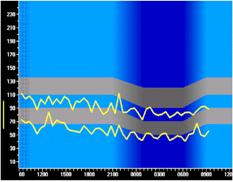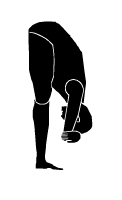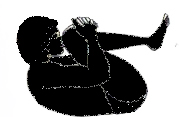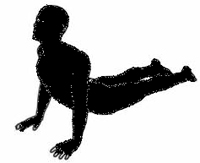Introduction

Low blood pressure is a problem only if it causes dizziness, fainting or in extreme cases, shock. If low blood pressure causes clinical symptoms, the cause will be in one of three general categories. The heart is not pumping with enough pressure, the artery walls are too dilated, or there is not enough intravascular fluid within the system. If you have an underlying medical problem that causes low blood pressure, seek treatment for the underlying condition. For many people, chronic low blood pressure can be effectively treated with diet and lifestyle changes like yoga and exercises.
Yoga and Hypotension
The benefits that come into your life through Yoga are so rewarding that once you start it is virtually impossible to stop. You feel better, look better, your skin is different, your diet changes and your outlook changes. Your heart starts to open and your attitude becomes more flexible and tolerant. Yoga is the key to opening up what is truly underneath. Once the body becomes flexible it starts to release pent up emotions and helps to correct defects in the posture. The body very soon becomes agile and lighter and a sense of wellbeing and confidence takes over. This is when the alchemical changes begin. It frees us of disease and brings the body, mind and soul together in harmony. Yoga asanas can be effective in different ways.In the case of blood pressure they can combat the causes, as well as the effects of high blood pressure and stabilize blood pressure thus reducing high blood pressure and regulating low pressure. Asanas calm the mind and regularize and balance the autonomous nervous system, the center that controls stress. The sympathetic and parasympathetic nervous system, which are involved in stress reaction also get stabilized in the practice of asanas resulting in regulation of blood pressure. If you have hypotension, or unusually low pressure, you may need to make some adjustments to the way you've been practicing yoga.
YOGA POSES FOR HYPOTENSION
Bharadvaja's Twist Pose
This gentle twist is a tonic for the spine and the abdominal organs.Camel Pose
The ushtra-asana is a powerful posture for stretching the spine, back muscles, shoulders and arms. It is best to practice it later in your asana routine after most of the muscles are limber and and you have worked the back and shouldersExtended side angle Pose
This pose strengthens and stretches the legs, groins, hamstrings. Opens the chest and shoulders. Stretch along the top side of the body, from the back heel through the raised arm.Fish Pose
The fish pose is the natural successor of the shoulder stand and should be used as a counter pose to the stand. There are several benefits of this pose. It helps expand the chest cavity, allowing the lungs to take in more air and to become more accustomed to deep breathing techniques. It also strengthens the neck muscles, makes the nerves more responsive and increases spinal flexibility.Half frog Pose
The half frog pose in Svaroopa Yoga is a sacral opening pose that relieves low back pain. It works to stretch the front of the legs and the front of the body while strengthening the arms and shoulders. The frog pose is an intermediate to advanced pose and is often a challenge for beginners, but a bolster can help as you gain the strength and flexibility you need.King Pigeon Pose
Invigorates your body and gives your spirits a lift. An extremely deep backbend appropriate for advanced Practitioners only.Marichi Pose
Marichi Pose or Marichyasana is a twist sitting pose. The pose purifies the body by wringing toxins out of the internal organs. This pose is also called Sages Pose. It helps with asthma, fatigue and digestive problems, along with working the spine, hips, abs, and lower back muscles.One-Legged King Pigeon Pose II
Nowadays we simply shoo pigeons away from our public gathering places. But in Vedic times, 3,000 years ago, the pigeon was a bird of ill omen, the messenger of the goddess Nirriti, a personification of misfortune, misery, and death. The One-Legged King Pigeon II, or Eka Pada Rajakapotasana II in Sanskrit, is one of the more intermediate back bends in yoga as it requires a certain amount of flexibility to get into the posture. While the pose does a great deal to stretch the thighs, its also good for the chest and back. If you want to sequence the One-Legged King Pigeon II into your routine, try using it before the Cobra, Bow or Hero.Tree Pose
The Tree Pose helps strengthen your thighs, calves, ankles and back. It can also increase the flexibility of your hips and groin. Your balance and concentration can also be improved with constant practice.YOGA ASANAS FOR HYPOTENSION
UTTANASANA

Steps
- Stand straight on the yoga mat.
- Inhale & raise hands above head palms facing to forward.
- Exhale & slowly bend forward try to touch toes or else you can touch the floor or to leg.
- Slowly you will be more comfortable in this asana /pose.
- Do not bend knees & try to keep neck relaxed.
- Maintain the pose & breathe normally.
- Inhale & return to original pose.
PAVANMUKTASANA

Steps
- Keep your hands by the side of your body in a supine position. While inhaling, raise both your legs to 90 and bend them at the knees.
- Make a finger-lock with both your hands around them, a little below the knees. While exhaling, bring your thighs close to the chest by contracting the abdominal muscles. Maintain this posture for a few seconds.
- Then return to the original posture in the reverse order as Ardha Pavan Muktasana. Repeat the asana three to four times.
BHUJANGASANA

Steps
- Lie on the abdomen on the floor.
- Bend elbows and bring hands close to the shoulder with palms placed on the floor.
- Inhale and raise hand, neck, chest & upper abdomen off the floor.
- Keep remaining part of the body on the floor.
- While doing this keep, hips, thighs, keens firm. Extend the neck fully & pull the shoulders backward.
- Maintain the pose & breathe normally
- Exhale & return to original pose.
PASCHIMOTTANASANA

Steps
- This posture involves stretching of the posterior muscles of the body.
- While sitting, stretch your legs forward and keep them close to each other. Bend a little forward, make hooks of your fingers and hold the big toes on the respective sides.
- While exhaling, bend forward stretching the trunk along the thighs. Rest your on the knees, which should be kept straight.
- Gradually, the tense muscles can be made supple for securing the complete posture. Inhale and return to the original position
SARVANGASANA

Steps
- Lie on the back quite flat. Slowly raise the legs.
- Lift the trunk, hips, and legs quite vertically. Support the back with the two hands, one on either side. Rest the elbows on the ground. Press the chin against the chest.
- Allow the back-shoulder portion and neck to touch the ground closely. Do not allow the body to shake or move to and fro. Keep the legs straight.
- When the Asana is over, bring the legs down very, very slowly with elegance and not with any jerks.
- In this Asana the whole weight of the body is thrown on the shoulders. You really stand on the shoulders with the help and support of the elbows.
- Retain the breath as long as you can do with comfort, and slowly exhale through the nose.
Diseases Related to Leo |
||


